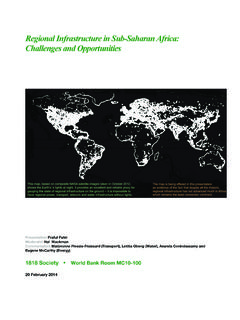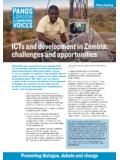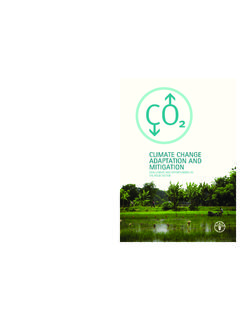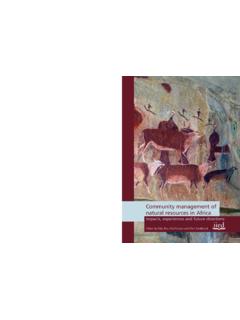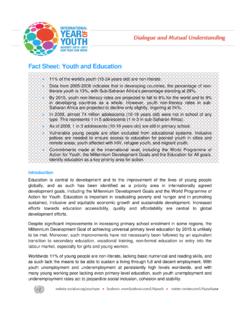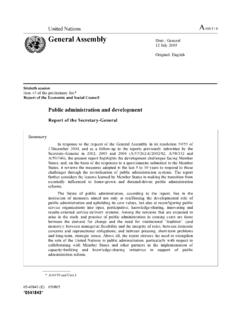Transcription of Developing the cold chain in the agrifood sector in Sub ...
1 Agroindustry Policy brief 2. Christine McIntosh Developing the Key messages cold chain in the ::Development of the cold chain facilitates food loss reduction, helps meet market require- agrifood sector ments for quality and safety, and improves food production and food security. in sub- saharan africa ::Development of the cold chain must be guided by a master plan, which should be integrated This policy brief was published by the Food and Agriculture into multi- sector and multi-stakeholder de- Organization of the United Nations (FAO) and the International velopment strategies that foster cooperation Institute of Refrigeration (IIR).
2 Within the value chain and public private and private private partnerships. ::A regional/subregional vision of development Introduction of the cold chain in sub- saharan africa , which This policy brief is based on the proceedings of the Re- adopts a complementary approach and takes gional workshop on the use of the cold chain into consideration economies of scale, is also in the development of agriculture and agro- recommended. industries in sub- saharan africa , organized in ::Governments and the private sector must pro- Yaound (Cameroon) in June 2012. The workshop mote the emergence of cold chain -based com- brought together speakers from diverse backgrounds modity associations and similar groupings that to analyse findings from case studies conducted in can serve as information and training channels food supply chains that included meat, fruits and while fostering the implementation of shared vegetables, fish and seafood, milk and dairy products.
3 Actions by the various stakeholders. Significance of the problem stimulating increases in production (IIR, 2009b). Devel- The lack of reliable and adequate cold chain facilities opment of the cold chain can therefore be considered in sub- saharan africa is one of the main causes of a necessary step towards achieving food and nutrition losses of perishable products, which are estimated to security. In spite of this need, however, cold chain de- be about 25 30 percent for animal products and velopment has not received the necessary attention 40 50 percent for roots, tubers, fruits and vegetables from governments and development organizations (FAO, 2011).
4 These losses result not only in a deterio- and therefore remains underused in comparison with ration of food security in all its dimensions, but also in the actual and potential needs of sub- saharan africa . loss of market opportunities, waste of the scarce re- sources (water, land and energy) devoted to producing the foodstuffs, and a significant ecological footprint. Reliable and efficient cold chains contribute not only to The current status of cold chains reducing these losses, but also to improving the techni- in sub- saharan africa cal and operational efficiency of the food supply chain . The reports on the status of cold chains that were pre- Cold chains thus facilitate compliance with quality sented by workshop participants from 16 countries and safety requirements and promote market growth, show that cold chains are currently very poorly devel- FAO/Saul Palma TABLE 1 Comparison of the cold storage capacity per capita in selected sub- saharan African countries United Republic Ethiopia of Tanzania Namibia South africa Capacity (litres/capita in urban areas) 2 2 15.
5 Source: IARW, 2012. Note: Data are for 2012, except for South africa , for which 2008 data are shown. TABLE 2 Production of perishable foodstuffs in sub- saharan africa in 2010, and average annual growth in production in 2000 2010. Total Fish production Roots and (capture and and average Fruits Vegetables tubers Meat Milk aquaculture) rate Production 72 063 33 802 225 494 11 332 24 000 6 140 372 831. (thousand tonnes/year). Annual growth 2000 2010 (%). Source: FAO, 2013. oped or inexistent in most subsectors in sub- saharan Freshly harvested carp from a fish pond africa , with the exception of some export-oriented chains targeting markets that are considered profit- able.
6 The International Institute of Refrigeration (IIR, 2009b) estimates that in developed countries (where 70 percent of the population is urban) cold storage capacity in urban areas is about 200 litres per capita, while in Developing countries (where 50 percent of the population is urban) it is about 19 litres per cap- ita. In emerging economies such as China, cold stor- age capacity is somewhere between these two levels. More precise but sparse data exist for some sub-Sa- FAO/DJibril Dram . haran African countries illustrating this situation very well (Table 1). Causes of the current situation Value chain actors who are considering investing in nificant opportunities for reaching more rapidly the cold chain development in sub- saharan africa face critical mass needed for cold chain market devel- challenges related to: i) access to energy; ii) mainte- opment in the region.
7 Regional production of perish- nance (shortage of qualified staff and spare parts); able foodstuffs, which was about 373 million tonnes iii) poor logistics arrangements; iv) weak organization in 2010, is expected to increase during the current and implementation of controls for compliance with decade at a rate that reaches or exceeds the annual standards; and v) relatively low traded volumes and 5 percent growth of the previous decade (Table 2). weak organizational arrangements for value chain activities. Strategies for cold chain development 1. Integrating cold chains into agricultural Promising prospects and food-security development strategies Despite these challenges, economic and demograph- more effectively ic trends in sub- saharan africa , including a growing Food losses increase differences in prices between middle class and increasing urbanization, offer sig- producers and consumers.
8 Lack of a reliable and 2. FAO/Marco Salustro adequate cold chain limits marketing opportuni- box 1 To bear in mind ties, hampers the development of production, and reduces the accessibility of products for consumers Equipment and energy efficiency (IIR, 2003): Cooling and the profitability for producers. Development of products and keeping them at low temperatures costs more in hot climates than in temperate ones. Any fac- cold chain logistics should therefore be an essential tor that can contribute to energy efficiency is particu- element in overall strategies for agricultural devel- larly important in sub- saharan africa : choice of suit- opment and food and nutrition security.
9 Able systems, use of good practices (maintenance, de- frosting, door closing, merchandise flow management, 2. Preparing multi- sector and cold store loading), selection of vehicle colour (as light multi-stakeholder strategies as possible), checking and improving insulation, etc. The cost of a reliable cold chain is not economically Solar-powered cooling requires high initial invest- sustainable unless production reaches a threshold ments (FAO and IIR, 2014) but provides an interest- in terms of volume and quality of products. Cold ing alternative in the absence of an electricity network. chains are also highly reliant on equipment mainte- In other situations, depending on the climate and the price of energy, cold storage and evaporative cooling nance, which requires qualified staff.
10 However, the may represent the most economical option. provision of training is feasible only when there are For transport, in the absence of refrigerated vehicles, sufficient operating systems to justify investments insulated vehicles can be used for some routes, pref- in training and to ensure long-term employment. erably with eutectic plates, which have high thermal These two requirements show that cold chains inertia that delays warming of the load (IIR, 2009a). need to be integrated into multi- sector and multi- Any option for reducing losses should be taken into stakeholder (agriculture, logistics, training, research consideration (IIR, 2009).)










